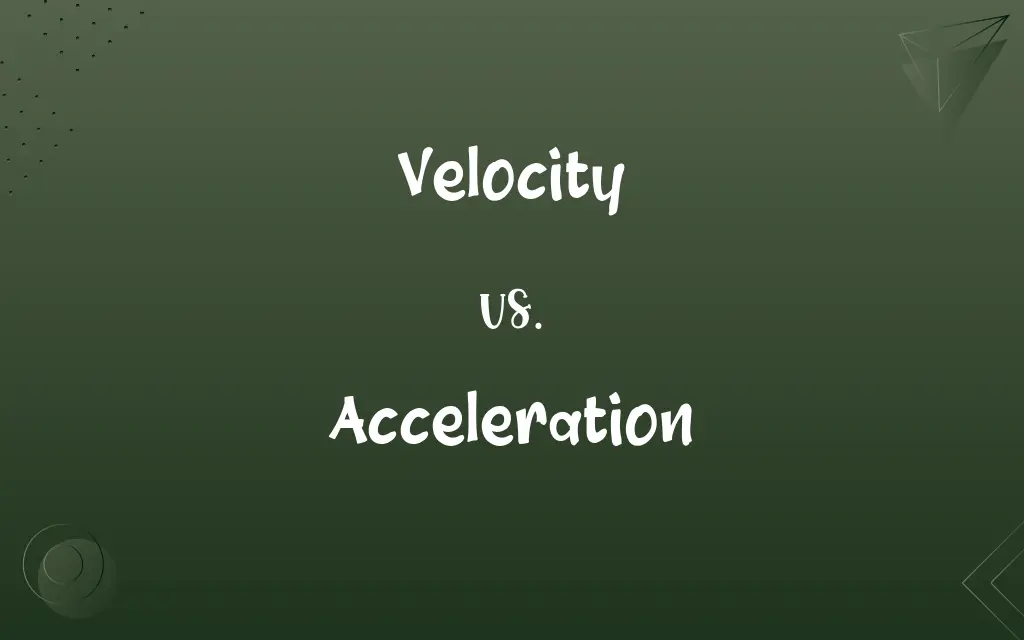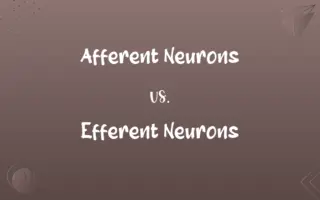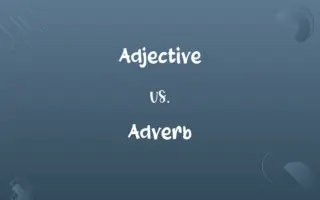Velocity vs. Acceleration: Know the Difference

By Shumaila Saeed || Published on January 26, 2024
Velocity is the rate of change of position of an object; Acceleration is the rate of change of velocity of an object.

Key Differences
Velocity is a vector quantity representing the rate and direction of the movement of an object. Acceleration, also a vector quantity, specifically measures the rate at which velocity changes, both in magnitude and direction.
Shumaila Saeed
Jan 26, 2024
Velocity gives a clear picture of how fast an object is moving and in which direction. Acceleration, on the other hand, informs us about the increase or decrease in velocity, offering insights into the forces acting on the object.
Shumaila Saeed
Jan 26, 2024
The calculation of velocity involves distance traveled over time, considering direction. Acceleration calculation focuses on the change in velocity over a period, reflecting how quickly an object speeds up, slows down, or changes direction.
Shumaila Saeed
Jan 26, 2024
Constant velocity implies no acceleration, as there is no change in speed or direction. However, if there is any change in velocity, even if the speed remains constant but the direction changes, this would result in acceleration.
Shumaila Saeed
Jan 26, 2024
The units of velocity are typically meters per second (m/s) in a specified direction. Acceleration's units are meters per second squared (m/s²), quantifying the change in velocity per unit time.
Shumaila Saeed
Jan 26, 2024
ADVERTISEMENT
Comparison Chart
ADVERTISEMENT
Velocity and Acceleration Definitions
Velocity
A vector measure of movement.
The ball's velocity was constant during its flight.
Shumaila Saeed
Jan 08, 2024
Acceleration
A vector quantity describing velocity change.
The roller coaster's acceleration caused a thrilling experience.
Shumaila Saeed
Jan 08, 2024
Velocity
Rate of movement in a specific direction.
The car moved with a velocity of 60 km/h northwards.
Shumaila Saeed
Jan 08, 2024
Acceleration
Change in velocity per unit time.
The rocket's acceleration was constant during launch.
Shumaila Saeed
Jan 08, 2024
Velocity
Speed with directional component.
The river's velocity increases near the waterfall.
Shumaila Saeed
Jan 08, 2024
ADVERTISEMENT
Acceleration
Rate of change of velocity.
The car's acceleration was noticeable as it sped up.
Shumaila Saeed
Jan 08, 2024
Velocity
Displacement per unit time.
The velocity of the wind was measured to be 20 m/s east.
Shumaila Saeed
Jan 08, 2024
Acceleration
A measure of how quickly velocity changes.
The train’s acceleration was gradual but steady.
Shumaila Saeed
Jan 08, 2024
Acceleration
Increase in the speed of an object.
The athlete's acceleration was key to winning the race.
Shumaila Saeed
Jan 08, 2024
Velocity
(Physics) A vector quantity whose magnitude is a body's speed and whose direction is the body's direction of motion.
Shumaila Saeed
Jan 06, 2024
Velocity
The rate at which something acts or occurs
The velocity of metabolism of glucose in muscle cells.
Shumaila Saeed
Jan 06, 2024
Acceleration
Abbr. a(Physics) The rate of change of velocity with respect to time.
Shumaila Saeed
Jan 06, 2024
Velocity
(physics) A vector quantity that denotes the rate of change of position with respect to time, combining speed with a directional component.
Shumaila Saeed
Jan 06, 2024
Acceleration
(uncountable) The act of accelerating, or the state of being accelerated; increase of motion or action; as opposed to retardation or deceleration.
A falling body moves toward the earth with an acceleration of velocity
Shumaila Saeed
Jan 06, 2024
Velocity
Rapidity of motion.
The train was travelling at a slower velocity than usual.
Shumaila Saeed
Jan 06, 2024
Acceleration
(countable) The amount by which a speed or velocity increases (and so a scalar quantity or a vector quantity).
The boosters produce an acceleration of 20 metres per second per second.
Shumaila Saeed
Jan 06, 2024
Acceleration
(physics) The change of velocity with respect to time (can include deceleration or changing direction).
Shumaila Saeed
Jan 06, 2024
Velocity
(economics) The number of times that an average unit of currency is spent during a specific period of time.
Shumaila Saeed
Jan 06, 2024
Acceleration
The advancement of students at a rate that places them ahead of where they would be in the regular school curriculum.
Shumaila Saeed
Jan 06, 2024
Velocity
Quickness of motion; swiftness; speed; celerity; rapidity; as, the velocity of wind; the velocity of a planet or comet in its orbit or course; the velocity of a cannon ball; the velocity of light.
Shumaila Saeed
Jan 06, 2024
Acceleration
The act of accelerating, or the state of being accelerated; increase of motion or action; as, a falling body moves toward the earth with an acceleration of velocity; - opposed to retardation.
A period of social improvement, or of intellectual advancement, contains within itself a principle of acceleration.
Shumaila Saeed
Jan 06, 2024
Velocity
Rate of motion; the relation of motion to time, measured by the number of units of space passed over by a moving body or point in a unit of time, usually the number of feet passed over in a second. See the Note under Speed.
Shumaila Saeed
Jan 06, 2024
Acceleration
An increase in speed;
Modern science caused an acceleration of cultural change
Shumaila Saeed
Jan 06, 2024
Velocity
Rate and direction of change in position.
The comet’s velocity brought it closer to Earth.
Shumaila Saeed
Jan 08, 2024
Repeatedly Asked Queries
How is acceleration different from velocity?
Acceleration is the rate of change of velocity, not just speed.
Shumaila Saeed
Jan 26, 2024
Are velocity and acceleration scalar quantities?
No, they are both vector quantities, having magnitude and direction.
Shumaila Saeed
Jan 26, 2024
Is it possible to accelerate without changing speed?
Yes, by changing direction while maintaining constant speed.
Shumaila Saeed
Jan 26, 2024
What is velocity?
Velocity is the rate of change of position with a directional component.
Shumaila Saeed
Jan 26, 2024
Can an object have zero velocity and still accelerate?
Yes, during directional changes or at the start of motion.
Shumaila Saeed
Jan 26, 2024
How do you calculate velocity?
Velocity is calculated as displacement divided by time.
Shumaila Saeed
Jan 26, 2024
What does zero acceleration imply?
The velocity is constant; there's no change in speed or direction.
Shumaila Saeed
Jan 26, 2024
What does negative acceleration mean?
It often refers to deceleration, where an object slows down.
Shumaila Saeed
Jan 26, 2024
How do gravity and acceleration relate?
Gravity is a force that causes a constant acceleration towards the Earth.
Shumaila Saeed
Jan 26, 2024
Can two objects have the same velocity but different accelerations?
Yes, if they are changing their velocities at different rates.
Shumaila Saeed
Jan 26, 2024
What is instantaneous velocity?
The velocity of an object at a specific moment in time.
Shumaila Saeed
Jan 26, 2024
How does acceleration relate to force?
Acceleration occurs when a force acts on a mass (Newton's Second Law).
Shumaila Saeed
Jan 26, 2024
Can an object have acceleration in the opposite direction of its velocity?
Yes, this typically indicates slowing down.
Shumaila Saeed
Jan 26, 2024
What is average velocity?
It's the total displacement divided by total time taken.
Shumaila Saeed
Jan 26, 2024
What is deceleration in terms of acceleration?
Deceleration is negative acceleration, where velocity decreases.
Shumaila Saeed
Jan 26, 2024
How do vectors play a role in understanding velocity and acceleration?
Vectors provide direction and magnitude, essential for both concepts.
Shumaila Saeed
Jan 26, 2024
What factors affect velocity?
Initial speed, direction, and forces applied.
Shumaila Saeed
Jan 26, 2024
Does changing direction always mean acceleration?
Yes, as acceleration includes direction change.
Shumaila Saeed
Jan 26, 2024
Share this page
Link for your blog / website
HTML
Link to share via messenger
About Author
Written by
Shumaila SaeedShumaila Saeed, an expert content creator with 6 years of experience, specializes in distilling complex topics into easily digestible comparisons, shining a light on the nuances that both inform and educate readers with clarity and accuracy.









































































